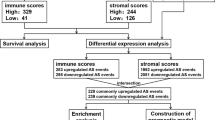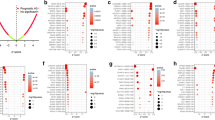Abstract
Background
Previous studies indicate that the splicing process, regulated by the cellular machinery of tumors (spliceosome), undergoes alterations, leading to oncogenic splicing events associated with the progression of tumors towards aggressiveness. However, the role of serine/arginine-rich splicing factor 7 (SRSF7) in hepatocellular carcinoma (HCC) and the tumor microenvironment (TME) remains unclear.
Methods
This study was aimed to explore the role and clinical significance of SRSF7 in HCC. By conducting functional analysis and gene set enrichment analysis, it was discovered that SRSF7 contributes to multiple pathways associated with immune response and tumor advancement. Further experiments verified that silencing of SRSF7 obviously inhibits progression of HCC.
Results
Aberrant expression of SRSF7, which were referred as an independent prognostic risk factor, effectively predicts the prognosis of patients with HCC. Functional and gene enrichment analyses revealed that SRSF7 is linked with multiple immune and tumor progression-related pathways, including the B cell receptor signaling pathway, positive regulation of leukocyte and immunoglobulin receptor binding cell activation, nuclear division, membrane invagination, cell cycle, as well as mTOR signaling pathway. Furthermore, increased SRSF7 expression was associated with tumor-infiltrating inflammatory cells (CD4+, monocytes/macrophages, CD8 + and endothelial). Additionally, multiple immune checkpoint genes were markedly positively related to SRSF7. The efficiency of SRSF7 in predicting immunomodulator and chemokine responses were also assessed in microenvironment. Moreover, in vitro analyses demonstrated that knockdown of SRSF7 suppressed the malignant evolution of HCC possibly by deactivating the PI3K/AKT/mTOR signaling.
Conclusion
The role of SRSF7 in the tumor microenvironment has been successfully assessed. It may be a valid bio-index for predicting the HCC prognosis, thereby guiding individualized immunotherapy for cancer.









Similar content being viewed by others
Data availability
The authors certify that all the original data in this research could be obtained from a public database. All data generated or analyzed during this study are included in this article.
References
Ashok C et al (2021) E2F1 and epigenetic modifiers orchestrate breast cancer progression by regulating oxygen-dependent ESRP1 expression. Oncogenesis 10(8):58
Bai X et al (2022) Adaptive antitumor immune response stimulated by bio-nanoparticle based vaccine and checkpoint blockade. J Exp Clin Cancer Res 41(1):132
Boguslawska J et al (2016) microRNAs target SRSF7 splicing factor to modulate the expression of osteopontin splice variants in renal cancer cells. Gene 595(2):142–149
Bray F et al (2018) Global cancer statistics 2018: GLOBOCAN estimates of incidence and mortality worldwide for 36 cancers in 185 countries. CA Cancer J Clin 68(6):394–424
Cavaloc Y et al (1994) Characterization and cloning of the human splicing factor 9G8: a novel 35 kDa factor of the serine/arginine protein family. Embo J 13(11):2639–2649
Chen Z, Hu H (2019) Identification of prognosis biomarkers of prostatic cancer in a cohort of 498 patients from TCGA. Curr Probl Cancer 43(6):100503
Chen J et al (2017) Identification of a DNA damage-induced alternative splicing pathway that regulates p53 and cellular senescence markers. Cancer Discov 7(7):766–781
Chen SH et al (2021) Dual checkpoint blockade of CD47 and PD-L1 using an affinity-tuned bispecific antibody maximizes antitumor immunity. J Immunother Cancer 9(10):e003464
Cheng F et al (2018) Capn4 promotes colorectal cancer cell proliferation by increasing MAPK7 through activation of the Wnt/β-Catenin pathway. Exp Cell Res 363(2):235–242
Coulie PG et al (2014) Tumour antigens recognized by T lymphocytes: at the core of cancer immunotherapy. Nat Rev Cancer 14(2):135–146
Cun Y et al (2021) Specific regulation of m(6)A by SRSF7 promotes the progression of Glioblastoma. Genom Proteom Bioinform. https://doi.org/10.1016/j.gpb.2021.11.001
Doak GR, Schwertfeger KL, Wood DK (2018) Distant relations: macrophage functions in the metastatic niche. Trends Cancer 4(6):445–459
de Miguel FJ et al (2014) Identification of alternative splicing events regulated by the oncogenic factor SRSF1 in lung cancer. Cancer Res 74(4):1105–1115
Esfahani K et al (2020) A review of cancer immunotherapy: from the past, to the present, to the future. Curr Oncol 27(Suppl 2):S87-s97
Fu Y, Wang Y (2018) SRSF7 knockdown promotes apoptosis of colon and lung cancer cells. Oncol Lett 15(4):5545–5552
Galiana-Arnoux D et al (2003) The CD44 alternative v9 exon contains a splicing enhancer responsive to the SR proteins 9G8, ASF/SF2, and SRp20. J Biol Chem 278(35):32943–32953
Hepatocellular carcinoma (2021) Nat Rev Dis Primers 7(1):7
Howard JM, Sanford JR (2015) The RNAissance family: SR proteins as multifaceted regulators of gene expression. Wiley Interdiscip Rev RNA 6(1):93–110
Huang Y, Steitz JA (2005) SRprises along a messenger’s journey. Mol Cell 17(5):613–615
Jiang Y et al (2019) Proteomics identifies new therapeutic targets of early-stage hepatocellular carcinoma. Nature 567(7747):257–261
Jin Y et al (2019) MicroRNA 32 promotes cell proliferation, migration, and suppresses apoptosis in colon cancer cells by targeting OTU domain containing 3. J Cell Biochem 120(11):18629–18639
Königs V et al (2020) SRSF7 maintains its homeostasis through the expression of Split-ORFs and nuclear body assembly. Nat Struct Mol Biol 27(3):260–273
Le QV et al (2019) Nanomaterials for modulating innate immune cells in cancer immunotherapy. Asian J Pharm Sci 14(1):16–29
Liu J et al (2020) Identification of a prognostic signature of epithelial ovarian cancer based on tumor immune microenvironment exploration. Genomics 112(6):4827–4841
Liu J et al (2021) Comprehensive of N1-Methyladenosine modifications patterns and immunological characteristics in Ovarian Cancer. Front Immunol 12:746647
Liu C et al (2022) A nanovaccine for antigen self-presentation and immunosuppression reversal as a personalized cancer immunotherapy strategy. Nat Nanotechnol 17(5):531–540
Liu J et al (2022) Pyroptosis-related lncRNAs are potential biomarkers for predicting prognoses and immune responses in patients with UCEC. Mol Ther Nucleic Acids 27:1036–1055
Mair F et al (2022) Extricating human tumour immune alterations from tissue inflammation. Nature 605(7911):728–735
Manley JL, Krainer AR (2010) A rational nomenclature for serine/arginine-rich protein splicing factors (SR proteins). Genes Dev 24(11):1073–1074
Nair M, Sandhu SS, Sharma AK (2018) Cancer molecular markers: a guide to cancer detection and management. Semin Cancer Biol 52(Pt 1):39–55
Nevola R et al (2023) Predictors of early and late hepatocellular carcinoma recurrence. World J Gastroenterol 29(8):1243–1260
Oshida K et al (2011) Novel gene markers of immunosuppressive chemicals in mouse lymph node assay. Toxicol Lett 205(1):79–85
Park WC et al (2016) Comparative expression patterns and diagnostic efficacies of SR splicing factors and HNRNPA1 in gastric and colorectal cancer. BMC Cancer 16:358
Raponi M et al (2011) Prediction of single-nucleotide substitutions that result in exon skipping: identification of a splicing silencer in BRCA1 exon 6. Hum Mutat 32(4):436–444
Reimand J et al (2019) Pathway enrichment analysis and visualization of omics data using g:Profiler, GSEA, Cytoscape and EnrichmentMap. Nat Protoc 14(2):482–517
Tam BY et al (2020) The CLK inhibitor SM08502 induces anti-tumor activity and reduces wnt pathway gene expression in gastrointestinal cancer models. Cancer Lett 473:186–197
Tan W, Wang W, Ma Q (2018) Physiological and pathological function of serine/arginine-rich splicing factor 4 and related diseases. Biomed Res Int 3819719:1–9
ten Dam GB et al (2000) Regulation of alternative splicing of CD45 by antagonistic effects of SR protein splicing factors. J Immunol 164(10):5287–5295
van Roosmalen W et al (2015) Tumor cell migration screen identifies SRPK1 as breast cancer metastasis determinant. J Clin Invest 125(4):1648–1664
Wang ZW et al (2022) SRSF3-mediated regulation of N6-methyladenosine modification-related lncRNA ANRIL splicing promotes resistance of pancreatic cancer to gemcitabine. Cell Rep 39(6):110813
Wu J et al (2021) A risk model developed based on tumor microenvironment predicts overall survival and associates with tumor immunity of patients with lung adenocarcinoma. Oncogene 40(26):4413–4424
Wu H et al (2022) Mapping the single-cell transcriptomic response of murine diabetic kidney disease to therapies. Cell Metab 34(7):1064-1078e6
Xu Q et al (2022) Circ_0006006 facilitates non-small cell lung cancer progression by modulating miR-924/SRSF7 axis. J Gene Med 24(5):e3411
Ye ZS et al (2021) Survival-associated alternative splicing events interact with the immune microenvironment in stomach adenocarcinoma. World J Gastroenterol 27(21):2871–2894
Yu G et al (2012) clusterProfiler: an R package for comparing biological themes among gene clusters. OMICS 16(5):284–287
Zheng Y et al (2020) Immune suppressive landscape in the human esophageal squamous cell carcinoma microenvironment. Nat Commun 11(1):6268
Zheng X et al (2020) Serine/arginine-rich splicing factors: the bridge linking alternative splicing and cancer. Int J Biol Sci 16(13):2442–2453
Zhou Y et al (2020) Posttranslational regulation of the exon skipping machinery controls aberrant splicing in leukemia. Cancer Discov 10(9):1388–1409
Funding
No funding.
Author information
Authors and Affiliations
Contributions
LY and FC conducted the formal analysis and wrote the original draft; WS performed the project administration; LY, FC conducted the experiments. ZW and XL participated in software analysis; LY, FC, ZW, and XL conducted data curation; LY and FC contributed to writing, reviewing, and editing the article; All authors read and approved the final submitted manuscript.
Corresponding author
Ethics declarations
Conflict of interest
All authors declares that there is no conflict of interest regarding the publication of this paper.
Ethical approval and consent to participate
Ethical review and approval were not required for the study on human participants in accordance with the local legislation and institutional requirements. Written informed consent for participation was not required for this study in accordance with the national legislation and the institutional requirements.
Additional information
Publisher’s Note
Springer Nature remains neutral with regard to jurisdictional claims in published maps and institutional affiliations.
Supplementary Information
Below is the link to the electronic supplementary material.
Rights and permissions
Springer Nature or its licensor (e.g. a society or other partner) holds exclusive rights to this article under a publishing agreement with the author(s) or other rightsholder(s); author self-archiving of the accepted manuscript version of this article is solely governed by the terms of such publishing agreement and applicable law.
About this article
Cite this article
Shen, W., Yuan, L., Cheng, F. et al. SRSF7 is a promising prognostic biomarker in hepatocellular carcinoma and is associated with immune infiltration. Genes Genom 46, 49–64 (2024). https://doi.org/10.1007/s13258-023-01463-w
Received:
Accepted:
Published:
Issue Date:
DOI: https://doi.org/10.1007/s13258-023-01463-w




